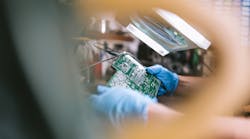Marvell, Qualcomm, Others Hit the Accelerator in 5G Base Stations
Companies—and countries—have been racing to build 5G networks, buying thousands of base stations in a bid to lead the technology arms race. Now, companies that supply the hardware at the heart of these base stations are helping them hit the accelerator.
Dell has rolled out a server-class accelerator card for 5G base stations that it co-developed with Marvell. The accelerator card is based on Marvell's Arm-based Octeon Fusion processor and brings a performance boost to virtual RAN (vRAN) and Open RAN networks.
A base station—also called the radio access network (RAN)—is a set of hardware modules that are usually mounted on poles or buildings and connect smartphones or other devices to a wireless network. The RAN includes a radio unit (RU) that houses radio-frequency (RF) transceivers and other ICs to convert and amplify RF signals. The radio unit is generally located close to or integrated directly into the antennas on a base station.
One of the other key components of a base station is the distributed unit (DU), which houses the baseband processor that runs L1 (or PHY) functions of the RAN protocol stack—or shares the load with the radio unit. The central unit (CU) is located in a telecom's cloud data centers, where it is used to run core management and 5G control functions. These “functional splits” allow for flexible partitioning of workloads in a network.
Dell said the accelerator can be plugged into the servers it sells to telecom giants, which are generally placed at the base of the pole the antennas and radio are mounted on. The accelerator card uses PCIe Gen 4 lanes to take over more of the real-time baseband and other signal-processing chores such as beamforming and massive MIMO from the server's CPU. In Dell's servers, the CPU is usually an Intel Xeon processor.
Open Acceleration
By taking over more of the baseband and signal-processing chores from the CPU, the Dell accelerator card runs them more efficiently, saving CPU performance that can be used by telecom firms for other workloads or services. Plugging the accelerator card into the base station also helps reduce the number of CPU cores that telecom companies are forced to buy per 5G base station, potentially cutting the cost of the hardware.
Power-hungry hardware can lead to thermal hot spots in the radio that require bulky, heavy heatsinks to stay cool. Delivering power into a base station is usually one of the largest operating costs in a wireless network.
The accelerator also supports the Open RAN standard, which promises to give telcos the flexibility to mix and match components of a base station from many different suppliers.
Ericsson, Huawei Technologies, Nokia, and other telecom equipment giants have long sold base stations in closed and proprietary bundles that combine in-house firmware and software running on custom hardware.
Dell said the Open RAN accelerator card that it developed with Marvell will be widely available by late 2022. The announcement by Dell and Marvell came ahead of Mobile World Congress (MWC) next month.
HPE Taps Qualcomm
HPE said that it has partnered with Qualcomm to build a DU solution based on its servers and Qualcomm's 5G X100 RAN accelerator cards to support high-capacity and low-latency workloads on future 5G networks.
HPE said it would use Qualcomm's 5G X100 accelerator card introduced last year in a new compact server specifically designed for base stations, with a data-center CPU from Intel inside. The unit can support up to four of the 5G accelerator cards, which can support the sub-6-GHz and millimeter-wave bands used by 5G networks. Qualcomm said the accelerator card can slot into any industry-standard server via a PCIe port.
The accelerator card gets placed in front of the CPU in the cluster of servers in the bowels of a base station to crunch data traveling from the radio unit directly without intervention from the CPU. As a result, it reduces latency that plagues wireless networks. Offloading beamforming and other baseband chores from the CPU also reduce the power the base station burns through, which, in turn, lowers cooling costs.
Tom Craig, VP of HPE's communications technology business, said the solution, which will also support Open RAN, will help telecom companies get a handle on the rigorous and ever-changing demands of 5G networks.
Qualcomm and HPE said the accelerator can reduce the cost of operating a 5G base station by up to 60%.
5G Radio Acceleration
Others are integrating accelerators directly into chips for other parts of a 5G base station, including the radio.
Analog Devices is trying to secure a larger slice of the market with its first family of 5G radio SoCs. The chips feature a wideband RF transceiver with eight transmit and receive channels that delivers 400 MHz of bandwidth, as well as a high dynamic range. A range of accelerator blocks inside the chip can handle digital-signal-processing jobs such as digital predistortion (DPD) that used to require the use of a field-programmable gate array (FPGA).
The company said the 13-W RadioVerse SoCs are ideal for small cells—clusters of short-range base stations deployed in cities—and macro base stations used by telcos for vast networks with tens of millions of users.
The SoCs, which can also slot into Open RAN base stations, can be paired with many of the most popular RF power amplifiers in 4G and 5G gear, including GaN power amplifiers with higher power densities.

